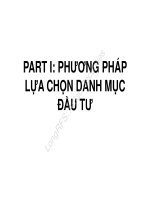1 mastering candlestick charts part i greg capra
Bạn đang xem bản rút gọn của tài liệu. Xem và tải ngay bản đầy đủ của tài liệu tại đây (214.93 KB, 51 trang )
Mastering
Candlestick
Charts 1
1
Disclaimer
It should not be assumed that the methods, techniques, or indicators presented in this book and seminar will be
profitable or that they will not result in losses. Past results are not necessarily indicative of future results. Examples in
this book and seminar are for educational purposes only. This is not a solicitation of any order to buy or sell.
“HYPOTHETICAL OR SIMULATED PERFORMANCE RESULTS HAVE CERTAIN INHERENT LIMITATIONS.
UNLIKE AN ACTUAL PERFORMANCE RECORD, SIMULATED RESULTS DO NOT REPRESENT ACTUAL
TRADING. ALSO, SINCE THE TRADES IN THIS BOOK and SEMINAR HAVE NOT ACTUALLY BEEN
EXECUTED, THE RESULTS WE STATE MAY HAVE UNDER OR OVER COMPENSATED FOR THE IMPACT,
IF ANY, OF CERTAIN MARKET FACTORS, SUCH AS LACK OF LIQUIDITY. SIMULATED TRADING
PROGRAMS IN GENERAL ARE ALSO SUBJECT TO THE FACT THAT THEY ARE DESIGNED WITH THE
BENEFIT OF HINDSIGHT. NO REPRESENTATION IS BEING MADE THAT ANY ACCOUNT WILL OR IS
LIKELY TO ACHIEVE PROFITS OR LOSSES SIMILAR TO THOSE SHOWN.”
The authors and publisher assume no responsibilities for actions taken by readers. The authors and publisher are not
providing investment advice. The authors and publisher do not make any claims, promises, or guarantees that any
suggestions, systems, trading strategies, or information will result in a profit, loss, or any other desired result. All
readers and seminar attendees assume all risk, including but not limited to the risk of trading losses.
Day Trading can result in large losses and may not be an activity suitable for everyone.
Copyright © 1994-2007 by Pristine Capital Holdings, Inc. All rights reserved. Printed in the United States of America.
Except as permitted under the United States Copyright Act of 1976, no part of this publication may be reproduced or
distributed in any form or by any means, or stored in a database or retrieval system, without prior written permission of
the publisher.
2
Table of Contents
Introduction
Candlestick Hype
Candle Benefits
Thoughts and Candle Language
Candle Basics
Individual Candles
Two-Bar Patterns
Three-Bar Patterns
Beyond the Basics
Pristine Candle Terms and
Understanding
Support & Resistance
Understanding Support and Resistance
A Deeper Understanding of Candles
Bar-by-Bar Analysis
Monitoring in Candle Language
Multiple Time Frames,
Volume and Indicators
General Understanding and Use
Candles in Action
Reading Greed and Fear in Candles
Combining the Candle Messages
Reversal Candle Potency
3
Candlestick Analysis
Cutting Through the Candlestick Hype
The signals on a bar chart are the same as a candle
chart.
Those signals will be seen at the same time and are
no more reliable than those of a bar chart.
The use of indicators will not increase the reliability
of candles.
There are no advanced candlestick patterns, but there is a deeper
understanding of price movements and that is the focus of The
Pristine Method®.
So, why use candle charts at all?
4
Candlestick Analysis
Why Use Candlesticks?
Provides a visual picture of what is occurring.
Gives visual insights into others’ thoughts and expectations.
Gives visual confirmation signals of support and resistance.
Can visually align your thoughts with the market.
Can visually point to potential reversal points.
Can a bar chart do this? Yes, but you can do it faster with candles!
5
Candlestick Analysis
Candle Language Produces Thoughts
Proper trading is said to be proper thinking, but how do we know
what to think?
Pattern recognition is a recurring arrangement of price bars that
suggests the future movement of prices, which guides our thoughts.
These patterns communicate how traders have acted and what their
beliefs (expectations) are in that time frame, at the moment.
Candles provide a picture of those expectations on an ongoing basis.
Those pictures speak to us in “Candle Language” and are the basis
6
for our continuous thoughts and trading decisions.
Candlestick Analysis
Miscellaneous Thoughts on Candlesticks
Attempting to define the accuracy of candle names or patterns
without considering the trend, support and resistance is useless.
There are a least 50 different candle patterns, bullish and bearish.
Some memorize them, but you will see this is completely unnecessary.
While candles are very good at visually showing reversal signals,
the signals that do Not work are often the most powerful!
All that is needed is a chart of price bars -- all else is secondary.
While other analysis tools may add additional information, they
can only follow existing price action.
7
Candlestick
Basics
8
Candlestick Analysis
Candlesticks show the same O, H, L, C information as Western bars, but
the battle between buyers and sellers is “visually” clearer.
Open
on Left
Close on
Right
Range
The Range of a bar is the difference
between the high and the low
Range
Closes above the
Open = Green
Closes below the
Open = Red
9
Candlestick Analysis
Candle Bars
Tail
Wick
Close
Open
Body
High
Open
Body
Low
Shadow,
Wick or Tail
Shadow,
Wick or Tail
Close
The candle body is the difference between the open and the closing prices.
The part on either side of the body is called a Shadow, Wick or Tail.
10
Candlestick Analysis
Let’s first review most individual candles and their names to
give you a background..
Remembering names is unnecessary because that will not
help you use candles or understand their meaning!
When we are done with this DVD, not only will you understand
what candles are saying, you will also:
Have a objective method of knowing when to enter
Know where to place a stop
Know how to monitor a position once in it
11
Candlestick Analysis
The Individual Candles
DOJI – A bar with the open and close at or very near the same price
Gravestone DOJI – A Doji with the open and close at the bar’s low
Dragon Fly DOJI – A Doji with the open and close at the bar’s high
Long Legged DOJI – A Doji with long upper and lower shadows
12
Candlestick Analysis
The Individual Candles
Spinning Top – A bar with a small body and small range,
after a multi-bar move.
High Wave – A bar with a small body and wider range, after
a multi-bar move.
Hammer – A bar with a small body (red or green), long lower
tail, and small to no upper tail, after a multi-bar down move.
13
Candlestick Analysis
The Individual Candles
Inverted Hammer – A bar with a small body (red or green), long
upper tail, and small to no lower tail, after a multi-bar down move.
Hangman – A bar with a small body (red or green), long
lower tail, and small to no upper tail, after a multi-bar up move.
Shooting Star – A bar with a small body (red or green), long upper
tail, and small to no lower tail, after a multi-bar up move.
14
Candlestick Analysis
Let’s begin to simplify all of these prior candles.
Single Candle Questions:
Were the prior candles moving up or down?
Was there a tail on the top, bottom or both sides of the body?
Was the body relatively small in relation to the candle range?
Interpretation – Momentum slowed down and there may have
been an increase in buying or selling.
15
Candlestick Analysis
As you can see, an individual
candle may or may not result in a
reversal.
High Wave
Long Legged DOJI
More information is needed for
them to be meaningful.
Shooting Star
DOJI
Shooting Star
Inverted Hammer
Spinning Top
DOJI
16
Candlestick Analysis
Two-Bar Combinations
Harami Cross Bullish – A DOJI inside a large red body.
Harami Cross Bearish – A DOJI inside a large green body.
Harami Bullish – A small green bar inside a large red body.
Harami Bearish – A small red bar inside a large green body.
17
Candlestick Analysis
Two-Bar Combinations Con’t
On Neck Line Bullish – A green candle that opens below the low
of a prior red candle (gap) and closes at the low of the prior candle.
Gaps
On Neck Line Bearish – A red candle that opens above the high
of a prior green candle (gap) and closes at the high of the prior candle.
In Neck Line Bullish – A green candle that opens below the low
of a prior red candle (gap) and closes at the close of the prior candle.
Gaps
In Neck Line Bearish – A red candle that opens above the high of
a prior green candle (gap) and closes at the close of the prior candle.
18
Candlestick Analysis
Two-Bar Combinations Con’t
Thrust Line Bullish – A green candle that opens below the low
of a prior red candle and closes inside the prior red candle’s body,
but below the midpoint.
Thrust Line Bearish – A red candle that opens above the high
of a prior green candle and closes inside the prior green candle’s
body, but above the midpoint.
Piercing Line Bullish – A green bar that opens below the
low of a red bar and closes above the midpoint of the prior bar.
Dark Cloud Cover Bearish – A red bar that opens above the
high of a green bar and closes below the midpoint of the prior bar.
19
Candlestick Analysis
Two-Bar Combinations Con’t
Engulfing Bullish – A larger green body engulfing
a smaller red body.
Engulfing Bearish – A larger red body engulfing a
smaller green body.
Separating Lines Bullish – A red candle followed by a green
candle that opens (gaps) at or near the prior candle’s open.
Close
Close
Separating Lines Bearish – A green candle followed by a
red candle that opens (gaps) at or near the prior candle’s open.
Open
Gap
Gap
Open
20
Candlestick Analysis
Let’s begin to simplify all of these prior candles.
Two Candle Combination Questions:
Were the prior candles moving up or down?
If a gap occurred, to what degree did it fail to follow through?
How far did the current bar retrace and close into the prior?
Was there a complete reversal of the prior candle?
Interpretation – Momentum has shifted to varying degrees.
21
Candlestick Analysis
Two-Bar Combinations
Engulfing
Bearish
Two-bar combinations are an improvement
over individual candles at signaling reversals.
Engulfing
Bearish
Engulfing
Bearish Harami
Bearish
Engulfing
Bullish
Now let’s look at
three-bar combinations
Thrusting
Line Bullish
Harami
Bullish
22
Candlestick Analysis
Three-Bar Combinations
Morning Star Bullish – The first bar is a long red bar; the
second gaps below the prior body; the third closes well into the first.
Gap
Evening Star Bearish – The first bar is a long green bar; the
second gaps above the prior body; the third closes well into the first.
Morning/Evening DOJI Star – Replace Star with DOJI
23
Candlestick Analysis
Let’s begin to simplify all of these prior candles.
Three-Bar Combination Questions:
Were the prior candles moving up or down?
To what degree did momentum slow and begin to shift?
To what degree did the next candle penetrate and close into
the prior candles?
Interpretation – Momentum slowed down, reversed and there
has been an increase in buying or selling.
24
Candlestick Analysis
Evening
DOJI Star
The three-bar patterns are
Evening
considered more potent than
Star
the single or two-bar patterns
Morning
DOJI Star
25









